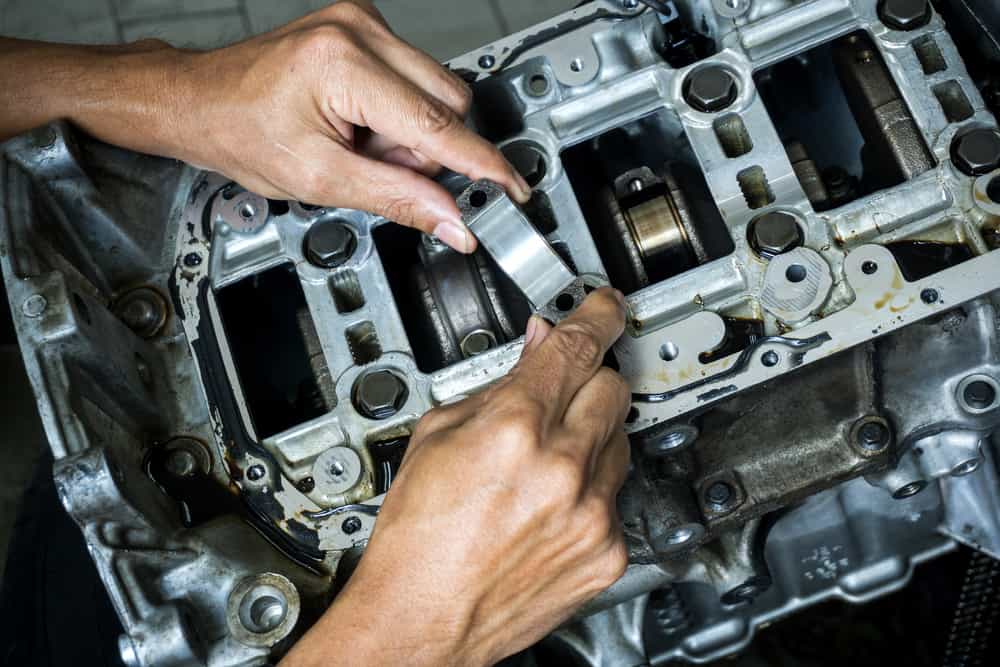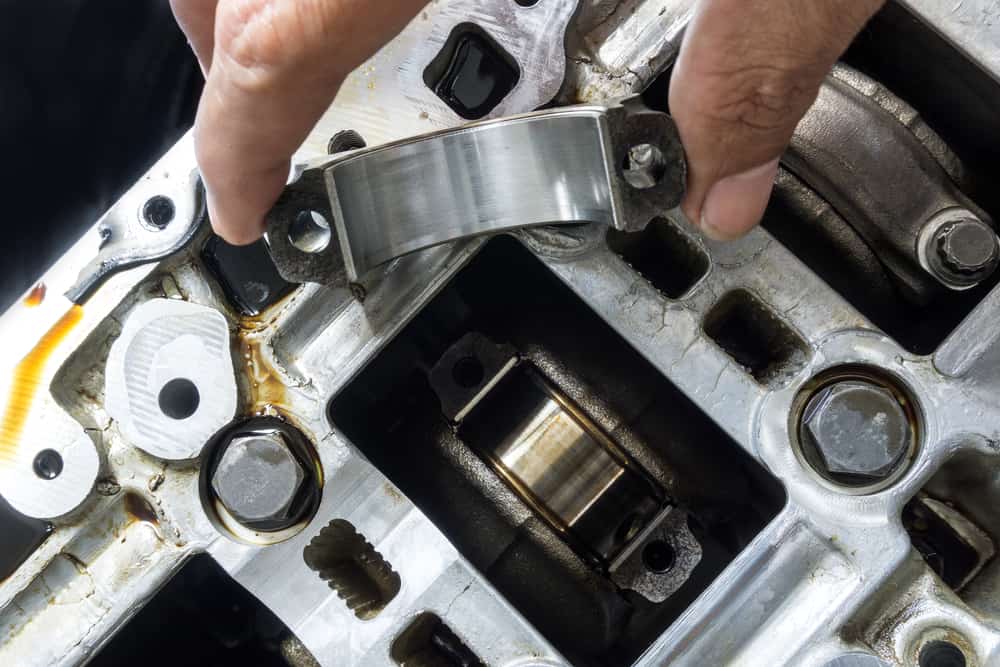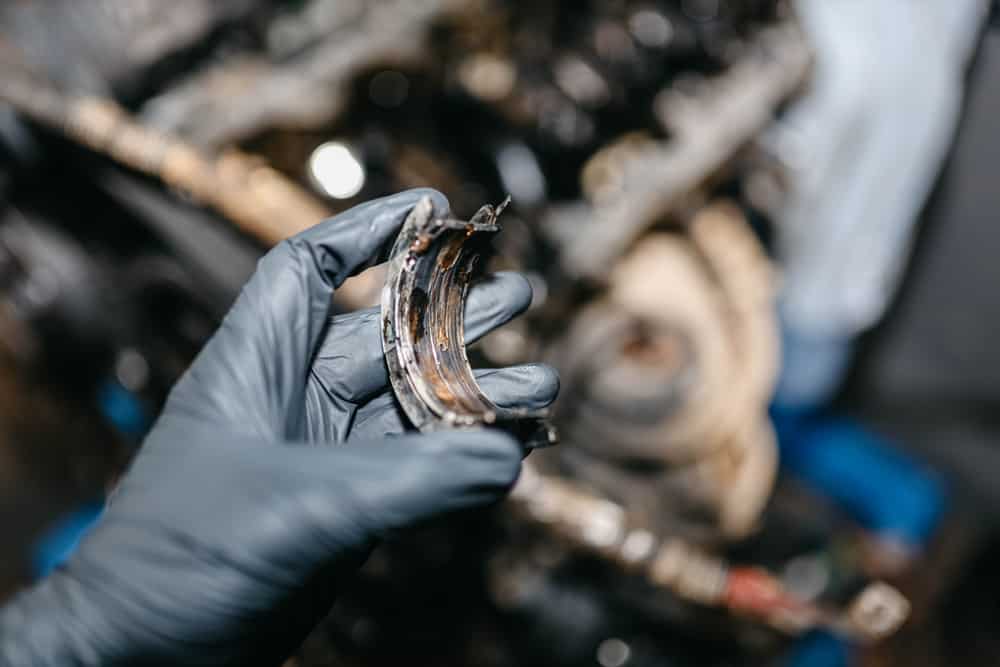If you’re having engine issues like knocking, power problems, or even failure to start, it’s a good sign the crankshaft is having issues. When that happens, the bearings are the most likely culprit.
In fact, most vehicles recommend changing the rod bearings every 60-80,000 miles. This means you’ll normally have to do it at least once over the lifespan of the car.

The average cost of replacing rod bearings is usually $2,000-$3,000, or about the same as rebuilding the entire engine. Here, you can expect about 8-20 hours of labor. Most bearings cost about $3-$10 each, or even less if you get them in larger packs. In addition, you’ll have to replace seals, gaskets, and oil pump seals.

The table below shows a quick price comparison of rod bearing replacement cost estimates from reputable suppliers:
| Supplier | Rod Bearing Cost | Labor |
|---|---|---|
| YourMechanic | $15-$62 | $752-$4000 |
| Midas | $17-$80 | $950-$3200 |
| Firestones | $25-$70 | $1500-$4070 |
| Pep Boys | $17.99-$70 | $1029-$3280 |
| AutoZone | $3.50-$267.99 | NA |
| Walmart | $17.39-$76.95 | NA |
| Amazon | $4.99-$765 | NA |
Compare Car Warranty Quotes For Free & Save Big!
Topics
How Much Does Rod Bearing Replacement Cost?*
In almost every case, the only major price consideration for replacing your rod bearings will be the cost of labor. That’s because the full job will take anywhere from 8-20+ hours.
In most cases, replacing the rod bearings requires full disassembly of the engine and may even require dropping the engine.
Therefore, the make and model of your vehicle will greatly impact the total costs.
For example, the following estimates cover normal price ranges for replacing rod bearings in popular vehicles.
| Vehicle | Rod Bearing | Labor Cost |
|---|---|---|
| Hyundai Sonata | $37.99-$455.88 | $1400-$3290 |
| Subaru Forester | $10.49-$329.99 | $1796-$3259 |
| BMW M5 | $3.99-$458.99 | $1900-$3780 |
| Chevy Avalanche | $3.99-$279.99 | $1610-$3220 |
| Ford F150 | $5.29-$97.99 | $1999-$3650 |
| BMW E46 M3 | $42.99-$425.99 | $1920-$3430 |
| Honda Element | $34.99-$283.50 | $1597-$3270 |
| Toyota Highlander | $24.99-$41.99 | $2112-$3280 |
| Nissan Xterra | $8.99-$48.99 | $2120-$3267 |
| Chevy Silverado 1500 | $3.69-$125.99 | $2190-$2386 |
| Ford Mustang | $7.29-$97.99 | $1910-$2740 |
*Note: Prices are estimates and were correct at the time of writing (June 2022). Cost estimates may have changed since, our figures should be used as a starting point for your own research.
Rod Bearing Replacement Price Factors
The cost of rod bearings can be considerable. However, most related costs are labor.
With most jobs taking anywhere from 8 to 20+ hours to complete, you’ll be paying your mechanic for a lot of hard work.

However, there are other factors that influence the cost of replacing your rod bearings as well.
Number of Rod Bearings
In most cases, you’ll have 2 main bearings per cylinder, or one on each end. In other cases, you’ll have one on each end and one in between every two cylinders.
This means you’re ranging from 8-12 for a 4-cylinder engine or 16-24 in a V8. On the other hand, many four-cylinder engines only have 3 bearings.
However, you’ll also have to replace rod bearings. These are less important for the function of the crankshaft but should normally be replaced.
Here, bearings can vary significantly. For example, high-end engines often use one rod bearing per crank pin.
Most engines won’t have that many, but you can normally factor in about double the number of main bearings.
Bearings are cheap and range from $3-$70 each depending on brand and type. However, replacing more bearings adds to labor and total time of the job as well.
Difficulty of Disassembling Engine
Some engines come apart very easily, may not require dropping or lifting the engine to replace the bearings, and may have plenty of clearance. This will make the job faster and easier, which will save you money.
On the other hand, some engines just require a lot more work. So, the total amount of work required depends a lot on how your vehicle was designed.
Other Parts Replaced
If your rod bearings are going out, it’s unlikely you can get away with replacing just the bearings. Instead, you’ll often have to replace the cylinder head bolts, gaskets, etc.
In addition, you might have to repair the pistons or the crankshaft in case the bad bearings damaged those. Worst case scenario, you might have to replace both.
For example, if you’ve spun a bearing, it will be “fused” to the crankshaft. This means the metal literally melts into the crankshaft – and repairing it is often impossible.
That will necessitate replacing the crankshaft, resurfacing the engine block, and possibly replacing the pistons.
Cost of Labor
Labor is almost always the largest cost in replacing rod bearings. Here, you’ll have to factor in the hourly rate charged by your mechanic, which is usually around $95-$100. However, rates vary from $15-$210 depending on where you’re located.
In addition, if you’re leaving your vehicle at the shop, you’ll have to pay lot fees. These are normally $5-$25 per day you leave your vehicle on the lot. And, with up to 20 hours of work needed, that could be several days.
Finally, you’ll pay a shop fee, which can be 5-20% of the total cost of the bill. And, if you’re paying $3,000 in labor, an additional 20% charge can be considerable, so be sure to factor it in.
4 Symptoms of a Bad Rod Bearing
If your rod bearings are going out, you’ll probably hear it before you notice anything else.

However, there are other symptoms you can pay attention to as well.
1. Oil Problems
If your oil pressure is low, you keep having to change the oil because of contaminate, or you’ve got metal shavings or a silver sheen to the oil, it’s a good sign the rod bearings are going out.
Modern engines use a sealed system in which the bearings operate fully submerged in fluid to reduce friction and reduce the chances of bearing failure.
When things start to go wrong, you’ll notice shavings in the oil, thin oil because it’s contaminated with gas, or low oil pressure.
These symptoms can mostly point to other issues as well, but the first two are almost always rod bearing issues.
2. Noisy Engine
Failing rod bearings knock. It’s called engine knocking for a reason and you’ll hear it.
This happens as the engine stops and starts and if the problem is very bad, when you’re idling as well. Here, a sound like striking metal normally indicates rod bearing issues.
3. Transmission Issues
If your transmission is grinding or belts keep wearing out, it may be a rod bearing issue.
This happens as rods stop transferring force to the crankshaft smoothly – which means more pressure and tension on the transmission.
4. Engine Failure
If your engine stops or fails completely, it may be a rod bearing issue. For example, a rod piercing the crank case is an extremely common cause of engine failure.
Of course, here, the question is if the repair is worth it or if you should just get a new short block.
Changing A Rod Bearing in 4 Steps
In most cars, you can complete a rod bearing replacement without dropping the engine first. However, that won’t always be possible. If you do have to remove the engine, rent a good cherry picker and have someone help.
It’s always a good idea to pull the engine so you can inspect the crankshaft journals and crankshaft. If these parts are worn or damaged, now is the time to replace them. Unfortunately, you can’t inspect or measure them with the engine in.
However, this is a long and difficult job. You will need some specialty tools. In addition, you’ll want to expect to spend several days on the job.
Things you’ll need:
- Wrench and ratchet set
- Spark plug puller (optional)
- Socket set
- Breaker bar
- Brake cleaner
- Replacement bearings
- Lubricant (Bearing Blue is recommended)
- Plastigauge
- Calipers
- Allen Wrench Set
- Disposable Gloves
- Penetrating Fluid
- Torque wrench
Replacing Rod Bearings
- Park your car on a clean and level surface. Set the parking brake. Then, take the key out of the ignition and remove the battery or unplug the battery from the negative terminal. Drain the engine oil.
- If you’re pulling the engine, do so now. Here, you want to remove connecting cables and hoses, remove the air intake, cover the throttle bodies, and remove the spark plugs. Find the motor mounts and unbolt them and then unbolt the motor from the transmission. Then, use a cherry picker or an engine support to lift the engine out. You may have to remove the radiator support as well. In addition, some vehicles require you to fully disassemble the steering shaft and hydraulics first. Make sure you check your vehicles repair manual first.
- Disassemble the engine so that you can reach the rod bearings. This normally means removing the oil pump, connector brackets, heat shields, and sensors. You’ll also want to take off the accumulator and high pressure lines as well as the bracket bolts holding it in place. Then, you can take the oil pan off. Then remove the oil pump.
- Unbolt the bearing caps from the top of the engine and lift them off. You’ll want to either mark them (chalk, paint, and markers are good) or place them in labelled containers. You may have to use a hammer and a screwdriver to hammer the bearing caps off. Then, use a wrench to rotate the crankshaft in a clockwise direction. Remove the bearing rod caps from each throw as it becomes visible.
- Thoroughly clean the bearing caps as you go. Then, clean the ends of the connecting rods with brake cleaner.
- Remove the bearing shells.
- Install the lower bearing halves, aligning the holes with those in the rod caps. Push inward and downward to get the shell to lock.
- Repeat the same process on the big end with the upper bearing shells.
- Apply a thin layer of assembly lube between the two layers.
- Replace the rods, pulling the big rod ends back down onto the crankshaft journal. Then, connect the rod caps. Rotate the crankshaft in clockwise direction and replace the bearings at each point.
- Once you have all bolts in place, you can torque them in place to manufacturer specifications.
- Replace the bearing caps.
- Reinstall the engine in reverse order.
You can also choose to replace the rod bolts at this stage.
You can also optionally choose to use plastigauge to assess the bearing fitting. If so, install it before tightening the bearings together.
Otherwise, use a set of calipers and torque to your manufacturer’s directions.
If you’re installing main bearings, it’s important not to rotate the crankshaft until the bearings are torqued down. If you’re just installing rod bearings, it’s not as important to do so.
FAQ
If you still have questions, this FAQ should help.
Is replacing rod bearings worth it?
That depends a lot on the condition and the cost of your engine.
For example, you can often buy a fully assembled (refurbished) short block for $2,000-$3,000. That may be a better call if you’re experiencing other issues with your engine as well.
How long does it take to replace rod bearings?
Normally you can expect it to take 8-20 hours to replace rod bearings.
However, you’ll likely have to replace other parts of the engine as well. Therefore, it’s always a good idea to drop the engine and inspect everything as you go.
What does rod bearing failure sound like?
You’ll normally hear a knocking sound, like hitting a fork on an aluminum plate.
If it’s a deeper knocking, the issue might be the main bearings instead.
To End
Rod bearing issues can mean the end of your engine if not dealt with quickly. Unfortunately, rod bearing replacement costs are also high, with most jobs costing between $2,000 and $3,000. Still, it’s a lot cheaper than replacing your engine and you can do the work yourself if you have the know-how.
Compare Car Warranty Quotes For Free & Save Big!
